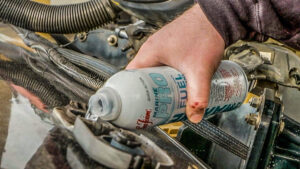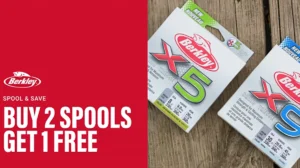Wired2fish recently conducted a survey for our friends at Sea Foam and the results were absolutely fascinating to study. Although it can seem like bass fishing is a rich man’s game at times, it was refreshing to see how many blue-collared anglers embrace older boats and motors. As they always say, the fish can’t see your boat!
This was particularly interesting to me since I run a 1999 bass boat paired with a 1998 outboard. Although I’ve had great luck with my rig thanks to obsessive preventative maintenance, I started experiencing some age-related issues last year. The motor would crank each I’d bump the key, but it sounded horrible as it idled. It would cough, smoke and often times choke itself out while I’d be trying to graph offshore structure with my electronics.
Thankfully, Sea Foam Marine PRO had just been released. I had used traditional Sea Foam for most of my life in small engines and what not; it’s what my dad always had sitting on the workbench in his shop. So with a high level of confidence in the brand, I decided to add some Marine PRO to my gas tanks.
By the end of the first day on the water, my motor was running like it did 10 years ago. That’s not some thinly veiled sales pitch, either. It was nothing short of amazing. My wife was in the boat with me and she could hardly believe the difference. Needless to say, since then I have been using Marine PRO nearly every time I put gas in my boat. It doesn’t choke itself out anymore, it stopped smoking and the hole shot is much quicker than before.
Now, I’m no mechanic and I won’t ever pretend to be. But the effectiveness of this product was too impressive for me to ignore; I wanted to learn more about why it worked and what made it different than other options out there. I sat down with Brian Miller, marketing director at Sea Foam and an avid (and talented) angler to ask him some important questions. Like many of us, Miller also owns an older bass boat and has become quite familiar with best practices for optimal performance and longevity.
What did you find out about W2F readers in the survey?
Most of the respondents fish more than 25 days a year, are “diehard” about their favorite species and spend a lot of time researching the products they buy. They’re serious about their fishing habit! It’s also very clear that anglers who spend time on W2F look across the whole media spectrum (online, TV, YouTube, product sites) when sourcing product information, suggesting that W2F’s site content is effective at triggering product search interest.
How old was the average boat?
The W2F survey results were virtually identical with current U.S. boat owner stats. Almost half of all registered fishing boats in use today are 11-20 years old. Then add the fact that another 20 percent of boats are older than 20 years. This is a great testament to North American boat and outboard manufacturers!
What are the two or three biggest engine problems people are concerned about? What should boat owners really be thinking about?
The big three engine concerns for boat owners are hard starting, rough running and loss of power. All these problems are typically caused by suspended fuel gum and sticky varnish residues that will restrict fuel passageways. Sea Foam has worked to solve fuel gum and varnish problems for more than 80 years.
Fuel treatments start to make a lot sense when you become aware of the gum and varnish problem. Sea Foam Marine PRO works great to handle gum and varnish problems, which is why it has been received so well by boat owners. It also helps to add a few gallons of fresh fuel to your tank on a regular basis, so you’re replenishing the light ignition vapor needed for chamber volatility.
You get asked a lot of questions about boat problems and fuel treatments. What would you say is the No. 1 thing boat owners should know about keeping their engine running strong?
Number one is to understand that gasoline degrades quickly. As fuel sits, light ignition vapors evaporate from the tank, while the remaining fuel becomes heavier, sticky and less volatile. Develop a smart fuel management attitude by adding less fuel at a time, but more frequently. Filling a boat tank and not running the engine for a month or longer is a bad habit. Keep space in the tank so you can always add volatile fuel right before the next outing.
What myths about fuel additives do you wish you could clear up?
Even though most common marine engine problems have always been caused by degraded fuel gum and varnish, many of today’s fuel additives are not capable of resolving gum and varnish issues, so no one talks about it. A boat owner who knows to manage the gum and varnish problem will not only enjoy trouble-free performance, but will also avoid unnecessary stress to the engine.
Lots of mechanics tell me to run the heck out of my 1998 outboard. Why is that?
That advice holds true for any outboard. If you run a gasoline engine passively, you’re not burning all of the fuel in the chamber, causing varnish to stick and build carbon deposits. Running your engine at high speed and chamber compression is critically important for the better health and longevity of the engine. Just like exercise and the health of the human heart, we need to be increasing the RPM on a regular basis.
Putting something other than oil and gas into an outboard can really freak people out, especially the more traditional anglers. What would you say to those people?
Sea Foam does a lot of surveys with a lot of different user segments. Every type of engine user tells us that they’re most concerned about two things: safety and effectiveness. They love that Sea Foam is always safe, made from 100% petroleum ingredients that can’t harm an engine. Two is that they hate the idea of wasting money on something that doesn’t work. Once you understand that most problems are caused by gum and varnish, you can rely on a fuel treatment like Marine PRO that actually works to prevent and overcome these issues (hard starting, rough running, loss of power).
What are some of the most important preventative maintenance tasks an outboard owner should perform? How often?
Don’t wait for parts to wear out. Stay a step ahead on all areas of maintenance every season. Any well-built boat motor should run like new for decades if taken care of. I like to pay a talented marine mechanic to give an outboard a look-over every three years. A better mechanic will know an engine’s reputation, vulnerabilities and where to look for wear and tear.
The newer outboards can cost a pretty penny. What primary advantages do they offer a bass angler who might be looking to re-power an older bass boat?
A ten to fifteen-year-old bass boat looks just as cool and slick as a new one. They really don’t change much when it comes to fishability and hull performance. If you need a new outboard or power head because the old one wore out or suffered damage, you can be money ahead to repower versus buying a whole new rig. When we consider that our outboards make or break the day, a re-power offers the security of warranty, reliability and “newness.” Not for everyone, but it can be a smart option for anglers who love their boat design and run a lot of motor hours.
















